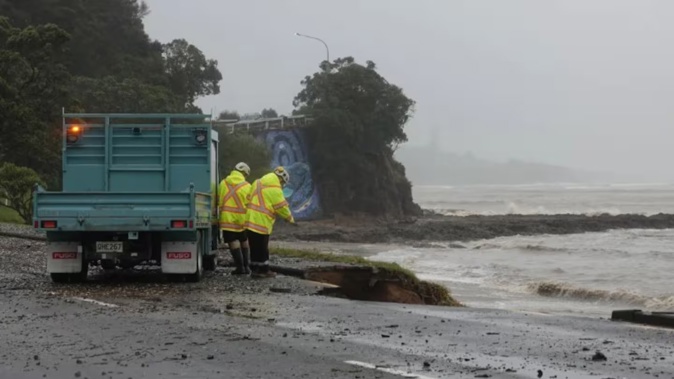
By Peter de Graaf of RNZ
First came the tornado that struck Mangawhai on January 26, tearing off roofs and leaving two people badly injured.
Then came the big dry, with some areas recording just 10% of their normal rainfall. Drought was declared on March 7.
Next, the heavens opened and Northland switched almost overnight from drought to flood. Kerikeri, Kaitāia and Whangārei all set new records for April rainfall.
Next, on April 17, Cyclone Tam trashed Northland’s power networks, leaving more than 24,000 households in the dark. It was a week before some homes regained power.
And it did not stop there, with slips triggered by more torrential rain closing State Highway 1 through Mangamuka Gorge twice in a matter of days.
MetService meteorologist Mmathapelo Makgabutlane said climate modelling did not suggest more cyclones in future.
“But what is expected is for them to become more extreme, so more rain and stronger winds. It’s the severity of those cyclones that is likely to change.”

Climate modelling suggests future cyclones and droughts will be more severe and frequent. Photo / Peter de Graaf via RNZ
Droughts were also expected to become more severe, she said.
Modelling by Niwa and the Northland Regional Council suggested droughts would be more frequent in future, and last longer.
However, Makgabutlane said it was too soon to say if the extremes of the past six months were “the new normal”.
“It has been quite tough on the ground in Northland, but it’s probably still a bit too early to say if this is how it’s going to be going forward.
“But it could be a hint of things to come.”
Far North Mayor Moko Tepania emphasises resilience and preparation as essential for coping with extreme weather.
Far North Mayor Moko Tepania said of the six summers since he was first elected as a councillor, only one had been free of drought or water restrictions.
Those dry conditions also led to major wildfires, and late summer often brought damaging cyclones.
“In my first full year as mayor, we had Cyclone Gabrielle and ex-Tropical Cyclone Hale hit us.
“I think there were 13 or 14 significant weather events that year as well. So it was really a baptism of wind and rain as mayor,” he said.
There had been little let-up since then.
“So it’s been a pretty crazy three years as mayor, six years as an elected member.”
Tepania said it was challenging for the Far North District Council to serve 75,000 people living in 40 settlements across a vast area.
Many of those people struggled daily just to get by.

Northland's new normal: Extreme weather tests resilience and infrastructure. Photo / RNZ
“You put on top of that the extreme weather we’ve been experiencing and it all adds up, and brings monumental challenges to us.
“The biggest one that I’ve probably had to deal with or seen affect our people on the daily is, of course, our roading network,” Tepania said.
“Our council has 2500km of local roads we have to look after. Cyclone Gabrielle caused over 140 slips across our network.
“We are still, to this day, working on 43 of those slips, and we will be spending something like $32.5 million over the next two years to still fix slip repairs that were caused by Cyclone Gabrielle two years ago.”
Damage on that scale also had a huge impact on rates in a district where many people struggled to pay their bills.
It was fortunate that NZTA Waka Kotahi picked up a large share of the bill through regular funding assistance, reflecting the district’s sprawling road network and affordability issues, topped up with emergency works funding.
Tepania said it sometimes felt like storms were lining up to have a go at the Far North.
Seeing Cyclone Tam bearing down in April brought back vivid memories of Cyclone Gabrielle.
“I was thinking, oh my goodness, we’ve only just got funding confirmation from NZTA to fix the remaining slips we’ve had since Cyclone Gabrielle, and we’ve finally got our tender panel up and running so that we can pump the work out to our contractors and get the work done a lot faster …
“And then you get another cyclone warning come through, and you see it tracking down, and you see the power going out across all of our towns, and you’re waiting for the reports to come back.
“It’s really frightening, to be honest.”
Tepania believed Northland’s recent weather extremes were part of a new normal.
He said he was proud of the work the council was doing to adapt to a changing climate, and helping communities prepare emergency response plans so they could better withstand future natural disasters.
He was also grateful to the NRC for flood reduction schemes under way in places like Awanui and Moerewa, and to NZTA for a project at Turntable Hill which had ended years of flooding across the state highway near Moerewa.
Tepania said Far Northerners had made it through all the extremes nature had thrown at them in recent years because they were resilient, and they were prepared.
“I don’t know what tomorrow looks like, I don’t know what the rest of this winter looks like. So trying to be as prepared as possible, and for our people to be as prepared as possible, is very important.”
- This is the first in a series exploring extreme weather in Northland, and what’s being done to prepare for it and reduce its impact.
-RNZ
Take your Radio, Podcasts and Music with you









